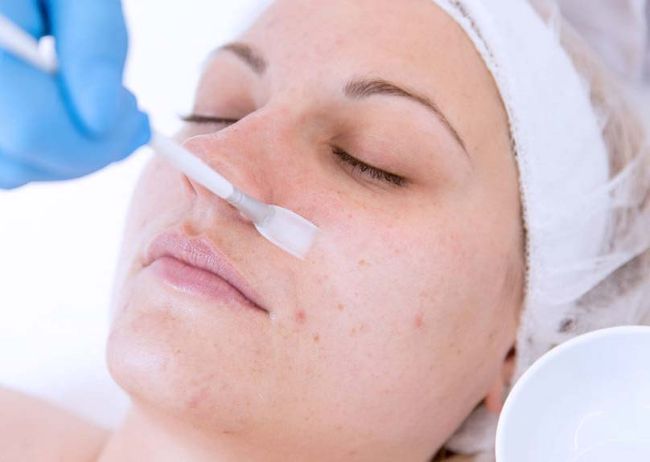Dermatologist
CHEMICAL PEELS

Dr Rasya Dixit Medical Director Dr Dixit Cosmetic Dermatology Clinic 16 years in practice
Dr Rasya Dixit, MBBS, MD-Dermatology, is a skin specialist and dermatologist in Bengaluru. She is a member of the International Society of Dermatology, the Indian Academy of Dermatology, the Cosmetic Dermatology Society of India, and the Association of Cutaneous Surgeons of India, to name a few. She has extended her training under senior dermatologists and aesthetic plastic surgeons world over. She believes that ongoing research and training to share and renew skills are of paramount importance in a fast-evolving cosmetic dermatology space.
Know more from Dr Dixit about chemical peels:
Who is a good candidate for Chemical Peels? How do you approach your patient to determine if this is the ideal treatment?
Chemical peels are simple, painless, and an affordable treatment that can address a variety of skin concerns, acne, acne induced pigmentation, tanning, melasma and photoageing. This treatment can also be used to enhance the glow of skin. As part of the treatment, a medicine is applied on the skin for a particular period of time. The peel then reacts with the skin, and removes the upper most layers of the skin in an even manner. This is called chemexfoliation. Different peels are used to treat different skin conditions as they penetrate and work on the different skin layers. Superficial peels such as Glycolic, Lactic, and Salycylic acid peels do not cause visible peeling of the skin, however, deeper peels such as TCA peels, Fenol peel, and Black peel, cause dryness and peeling that may last for up to five days post treatment.
Any patient who is looking to have clearer skin is a good candidate for this treatment. While the earliest age to have this treatment would be 18 years, there is no upper age limit. The newer trends include body peels to help with tanning and pigmentation.
Care needs to be taken for clients with extremely dry skin as many peels may not be suitable. However, lactic acid peels work well in this segment. Moreover, peels also need to be temporarily avoided if there is any active infection or eczema over the area to be peeled.
How can best results be derived from this treatment and within what timeframe? Tell us about the technique and the number of sittings required?
Chemical peels work by exfoliating the upper layers of the skin. This not only removes the dead skin giving a fresh appearance, but also unclogs pores and promotes new skin formation. Although we can appreciate clearing of the skin from the first session, usually a set of six to eight treatments done fortnightly help in getting best results. The results also depend on the choice of peel and the indication. Some deeper peels can be repeated only once a month.
The procedure of chemical peels is simple. First, the skin is cleansed of makeup and sunscreen. Then, the peeling cream or solution is applied in multiple layers. The skin feels itchy or tingly. Once the duration of peel is completed, the peel is neutralized with a neutralizing solution, which is then washed off with water. A bland moisturizer and sunscreen are then applied.
What is the recovery time for a patient who opts for this treatment? What is the post-treatment care involved?
The recovery time for a peel depends on the nature of the peeling solution used. Superficial peels such as Glycolic, Lactic, and Salycylic acid peels do not cause visible peeling of the skin. However, deeper peels such as TCA peel, Fenol peels, and Black peel cause drynesss and peeling that may last up to five days post treatment.
The peeling may take anywhere between three days to a week. During this time, the skin may look dry, dark or patchy and feel rough to touch. This is expected, and skin will return to normal within a few days. During this time, you may also notice flakiness and peeling of the skin. This commonly starts around the mouth, and then slowly involves the full face. In a rare scenario, one may not notice any peeling, but will still continue to benefit from the treatment as the peeling is happening at a microscopic level.
The skin is sensitive just after a peel. Use a pH balanced, soap-free cleanser twice a day. Frequently apply bland emollients containing hyaluronic acid or ceramides. Avoid products containing retinols or glycolic acid for at least a week after the peel, as they may irritate the skin.
Some common side-effects post the treatment include redness, tightness of skin, and mild scabbing. These are temporary and resolve within two to three days. Avoid picking at or peeling off the scabs as it could cause scarring and pigmentation. If scarring and pigmentation does occur, the dermatologist can prescribe a mild topical steroid cream to help the skin settle down faster.
Chemical peels can reactivate herpes labialis (cold sores or fever blisters). If the patient develops sores after peels, he/she may need oral antiviral medicines to help. One must remember to cleanse gently, moisturise frequently, and protect the skin with sunscreen!
Any contraindications involved that one should be aware off? Also, is there anything the patient must not do after the treatment?
•Avoid sun exposure for up to a week post the peels, and make sure to use a broad spectrum sunscreen if a need arises to step out in the sun.
•Avoid exercise, steam and sauna for 72 hours as the increased heat could irritate the sensitive skin.
•Avoid facials, scrubs, bleaching, waxing or threading the face for a week after peels.
•Avoid products containing retinols or glycolic acid for at least a week after the peel.
Tell us about one of the most challenging case studies that you have dealt with for this treatment, and why?
Acne can often leave pigmentation, and especially in women planning pregnancy, we cannot offer oral medications. Also, creams such as retinoids are contraindicated. In such patients, scheduling the peels during the periods allows us to overcome acne and pigmentation and help bring the same under control.

Picture: For representational purpose